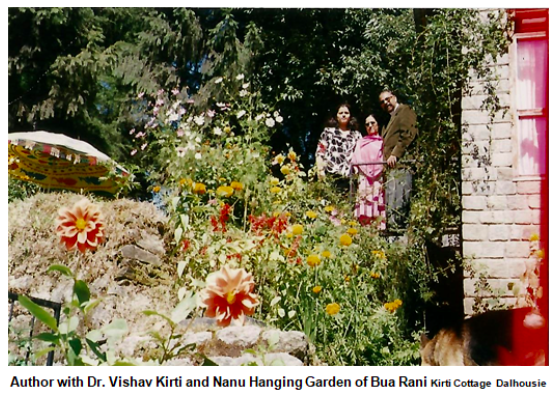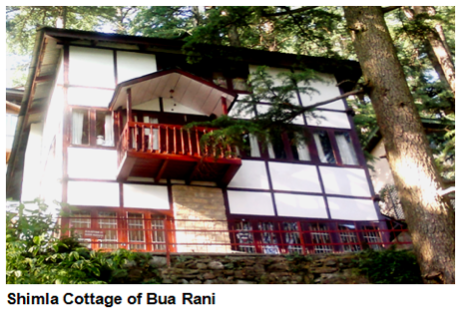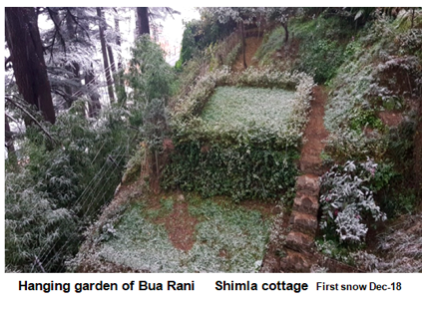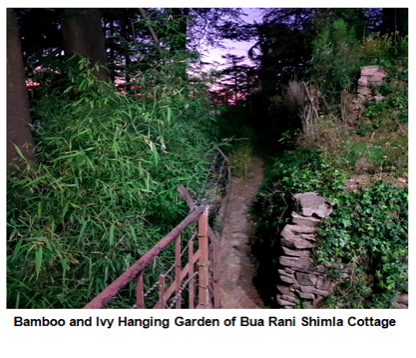- Hanging Garden of Kirti Cottage, Dalhousie
Back home from Denmark in 1983, I had an urge to build a cottage in Dalhousie; and along the house, a Hanging Garden for my wife, Bua Rani. The area of the land was on the slopes of Potryn Hill, South East, behind the Sacred Heart convent School. Idea was to plant the grass, trees, flower beds in to an artistic garden adjoining the dwelling and even attached to the walls; a garden sustained at an artificial elevation like the mythical terraces of the ‘Hanging gardens of Babylon’ built by King Nebuchadnezzar II to make his wife, Amytis of Media, happy. The Gardens are the only one of the Seven Wonders of the ancient world that may not even have existed. If it existed it was likely the most beautiful man-made gardens ever created.

- Soon I crafted a ‘card board prototype’ of the hut out of my imagination, while in Dharamshala. My wife & sons- Aseem and Manu carried on, for months, with the additions and alterations in the elevations and fixing the railings with toothpicks, whatsoever they may have liked, before we gave it an ultimate shape. We came up with a split level design of the hut with attached gardens.
- We were planning to build the garden high above the ground on split-level stone terraces where the plants would look as ‘floating’ but they, instead, would hang from these different terraces, giving them the appearance of being suspended in mid-air.

- In the ‘Hanging Gardens’, the plants would not actually hang.
- They would grow from many different levels of terraces (similar to balconies).
- The word ‘hanging’ comes from the Latin word ‘pensilis’ or the translation of the Greek word ‘kremastos’.
- It actually means overhanging instead of just hanging.

I had vague images of the landscape mingled with plantations of Hanging Gardens in Mumbai that I had visited a long time before; the terrace garden is located on a hill slope. The park was laid out, some say, to cover the water from the potentially contaminating activity of the nearby Towers of Silence. The other day after my presentation on the subject in Laureate Public School, Shimla., Mr. Deepak Bhasin, Vice President of SAGES, amongst the learned audience commented that gardens were synonymous with excarnation by Zoroastrians.

- To begin with we had an inbuilt advantage of the ancient terraces on the slopes and the natural growth of trees and shrubs as also the wild flowers.
- The hut perched on a rock. To etch the contours, it had to be cut, chipped and dressed to carve the foundations. The rock bits and debris became handy to build the terraces in loose stone masonry. The dark loose soil from below the trees and surroundings; that may have piled up from times primitive, proved much useful to fill and level up the sockets on the terraces.
- We notched mini gardens adjoining each room of the cottage.
- We planted dahlias, hydrangeas, marigold, chrysanthemums, lilies; sunflowers and adore the terraced hanging gardens on the hill slopes dahlias, hydrangeas, marigold, chrysanthemums, lilies; sunflowers and Begonias in benches. On the walls and retaining structures we put creepers and climbers native to the environment and surrounding ,to adore the hanging garden of ‘Bua Rani’.
- Hanging Garden of Shimla Cottage, Shimla

- In 2005, When we migrated to our ‘Shimla Cottage’, Jhakoo, the crown of Shimla, amidst thickly wooded Cedars, we were overwhelmed by the scenery and panorama. Here, Prospective Hanging Garden of Bua Rani, in the making, was in shambles. The hut was surrounded by heaps of loose dirt and soil with a few natural slopes of the hill. There was hardly any privacy, with the exteriors open to view from the road side as also from neighboring cottages.
- Knowing well my wife’s likes and tastes, I started carving the land in to a garden by molding the clay and dust in to terraces of artistic designs and shapes. The beauty of the majestic Deodars added charm to the grassy green patches, the foliage and wild flowers. We found the place was conducive to grow Bignonias, roses, hydrangeas and merry gold, besides the local shrubs and flowers. Ivy did icing on the cake.
- Idea was to come out with a quick growth in to an attractive garden. Owing to limitations and constraints of the vagaries of weather as also the population of the wild animals on an increase, We chose to plant species of ornamental bamboos native to cool mountainous regions to begin with.
- The effects have been amazingly encouraging. It’s most magical use is in a small grove. A grove of bamboo need not require a large property. We have succeeded in growing a lovely bamboo grove even on the terraces of the hanging garden of our cottage in the city. It provides as a screen to block offensive views and is now an accent plant in the garden. They are the bamboo grower’s aesthetic equivalent of flowers.

- Bamboo grows naturally without the aid of pesticides or fertilizer and requires very little water. Bamboo is an evergreen perennial flowering plant, a Beautiful Grass that Thinks It’s a Tree. It includes some of the fastest-growing plants in the world.
- Watching the new bamboo shoots emerge in the spring and early summer is a phenomenon unlike any other a gardener is likely to experience.
- Bamboo is an attractive plant for bird species. The shoots and leaves provide birds with good nesting material, while the plants themselves are an excellent source of cover.
To and fro Dalhousie and Shimla, we are a happy family between ‘Hanging Gardens of Bua Rani’
‘leading a person up the garden path is to mislead or deceive a person’ is an idiom (informal)
Prof. (Er.) Chander P Mahajan is an art critic & a free lance journalist. The Environmentalist stays in Shimla and Dalhousie, Himachal Pradesh, India.


